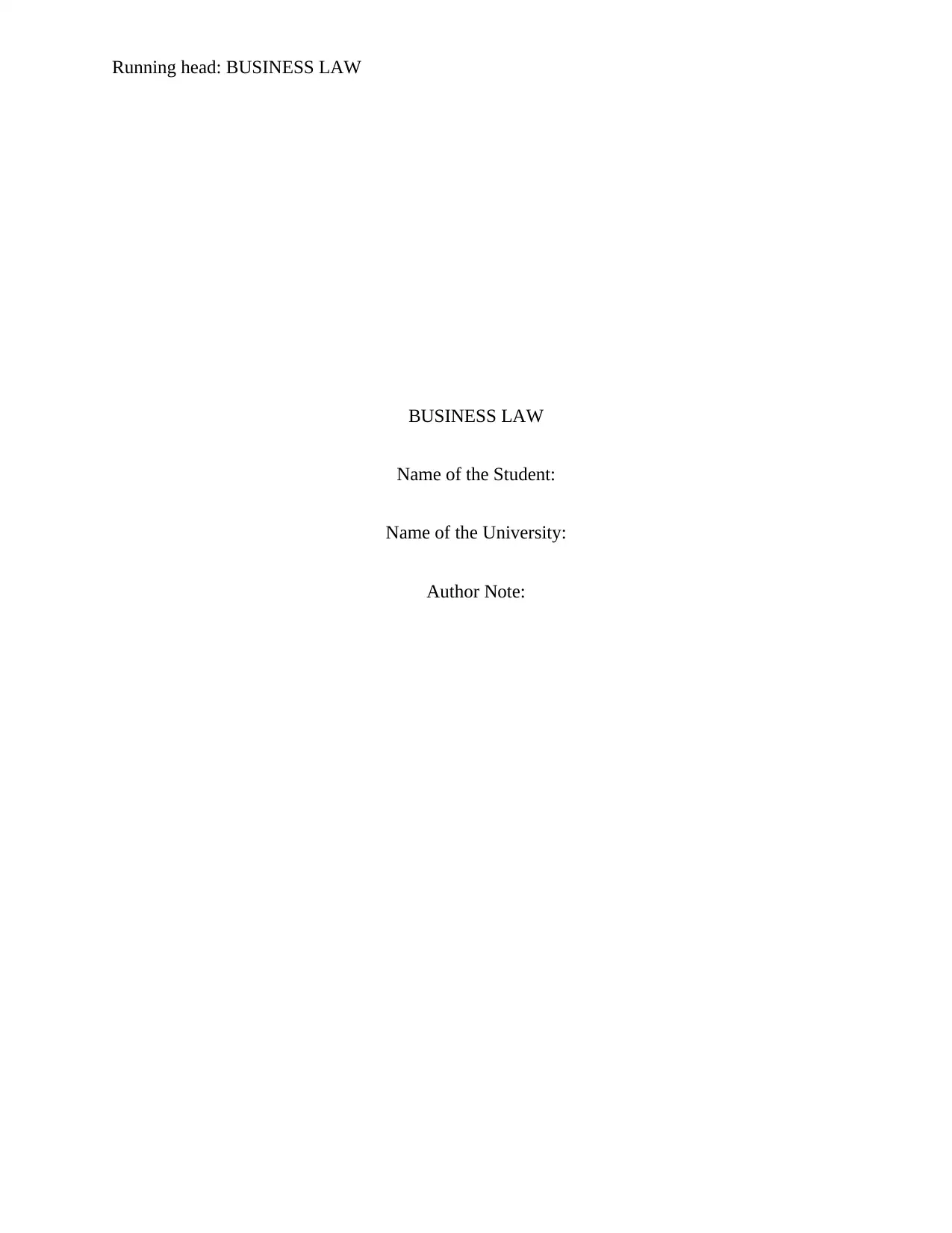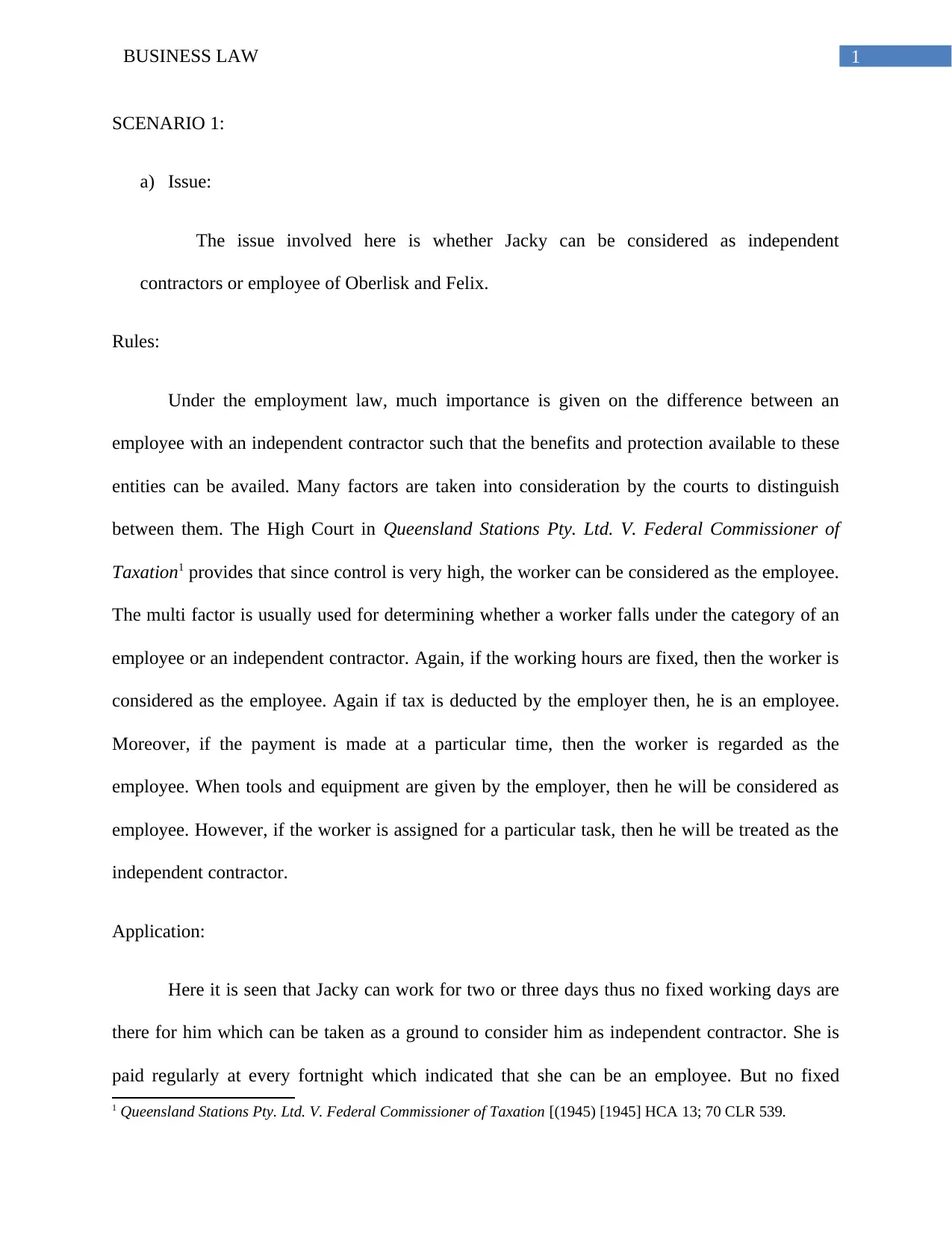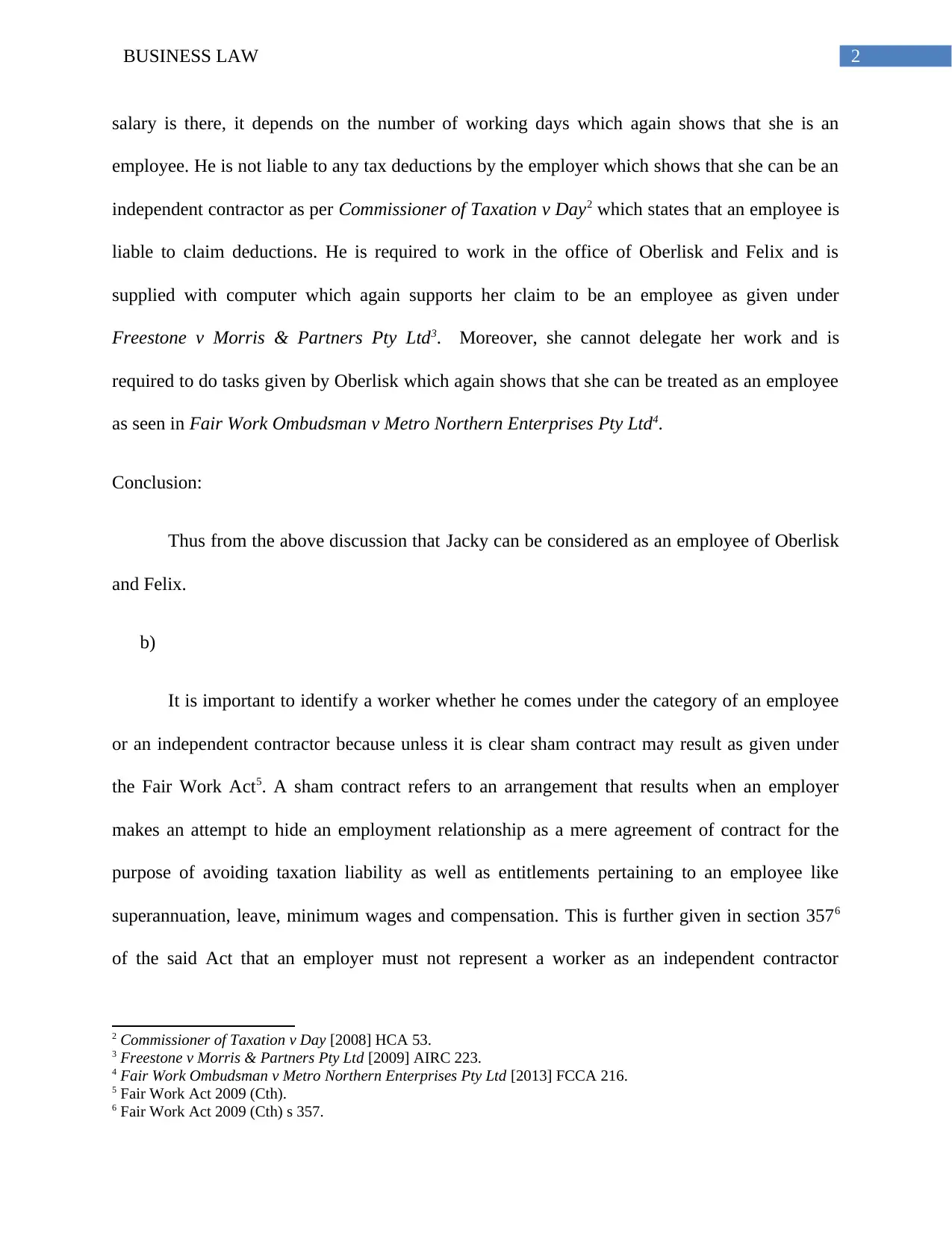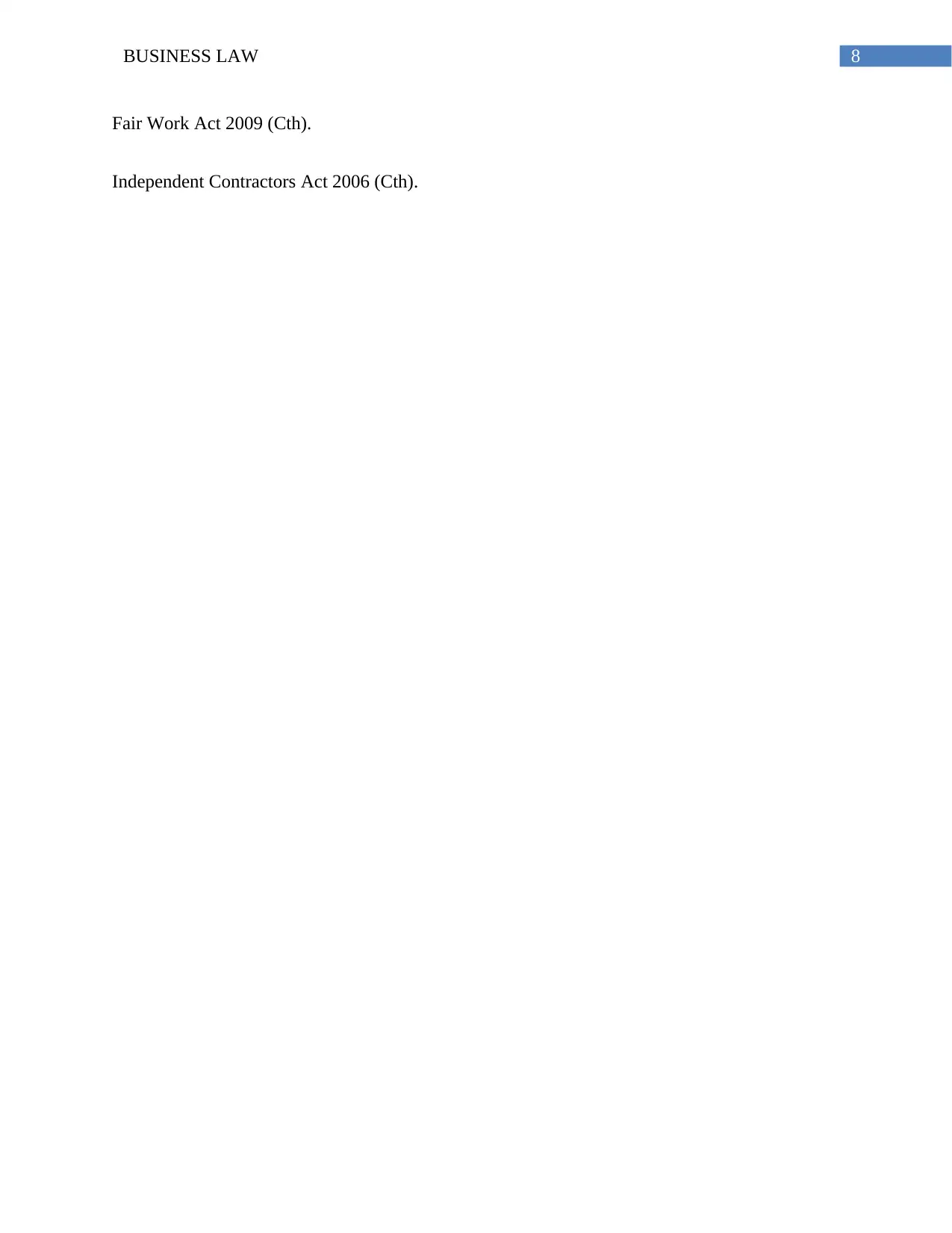Business Law LAWS1018 Case Study: Employment and Agency Issues
VerifiedAdded on 2022/10/04
|9
|1769
|12
Case Study
AI Summary
This business law case study examines two scenarios. The first scenario focuses on determining whether Jacky is an employee or an independent contractor for Oberlisk and Felix, analyzing factors such as control, fixed working hours, tax deductions, and delegation of work. The case study references relevant employment law, including the Fair Work Act and its provisions against sham contracting. The second scenario addresses whether Better Building Company Ltd (BBC) can successfully claim against Oberlisk and Felix, delving into agency law, vicarious liability, and ostensible authority. It considers the roles of BBC, Property Management Company Ltd (PMC), and the application of the doctrine of indoor management (Turquand's Rule) and the Corporations Act 2001 to determine liability in a leasing dispute. The case study concludes that Jacky is likely an employee and that BBC cannot claim against Oberlisk and Felix.

Running head: BUSINESS LAW
BUSINESS LAW
Name of the Student:
Name of the University:
Author Note:
BUSINESS LAW
Name of the Student:
Name of the University:
Author Note:
Paraphrase This Document
Need a fresh take? Get an instant paraphrase of this document with our AI Paraphraser

1BUSINESS LAW
SCENARIO 1:
a) Issue:
The issue involved here is whether Jacky can be considered as independent
contractors or employee of Oberlisk and Felix.
Rules:
Under the employment law, much importance is given on the difference between an
employee with an independent contractor such that the benefits and protection available to these
entities can be availed. Many factors are taken into consideration by the courts to distinguish
between them. The High Court in Queensland Stations Pty. Ltd. V. Federal Commissioner of
Taxation1 provides that since control is very high, the worker can be considered as the employee.
The multi factor is usually used for determining whether a worker falls under the category of an
employee or an independent contractor. Again, if the working hours are fixed, then the worker is
considered as the employee. Again if tax is deducted by the employer then, he is an employee.
Moreover, if the payment is made at a particular time, then the worker is regarded as the
employee. When tools and equipment are given by the employer, then he will be considered as
employee. However, if the worker is assigned for a particular task, then he will be treated as the
independent contractor.
Application:
Here it is seen that Jacky can work for two or three days thus no fixed working days are
there for him which can be taken as a ground to consider him as independent contractor. She is
paid regularly at every fortnight which indicated that she can be an employee. But no fixed
1 Queensland Stations Pty. Ltd. V. Federal Commissioner of Taxation [(1945) [1945] HCA 13; 70 CLR 539.
SCENARIO 1:
a) Issue:
The issue involved here is whether Jacky can be considered as independent
contractors or employee of Oberlisk and Felix.
Rules:
Under the employment law, much importance is given on the difference between an
employee with an independent contractor such that the benefits and protection available to these
entities can be availed. Many factors are taken into consideration by the courts to distinguish
between them. The High Court in Queensland Stations Pty. Ltd. V. Federal Commissioner of
Taxation1 provides that since control is very high, the worker can be considered as the employee.
The multi factor is usually used for determining whether a worker falls under the category of an
employee or an independent contractor. Again, if the working hours are fixed, then the worker is
considered as the employee. Again if tax is deducted by the employer then, he is an employee.
Moreover, if the payment is made at a particular time, then the worker is regarded as the
employee. When tools and equipment are given by the employer, then he will be considered as
employee. However, if the worker is assigned for a particular task, then he will be treated as the
independent contractor.
Application:
Here it is seen that Jacky can work for two or three days thus no fixed working days are
there for him which can be taken as a ground to consider him as independent contractor. She is
paid regularly at every fortnight which indicated that she can be an employee. But no fixed
1 Queensland Stations Pty. Ltd. V. Federal Commissioner of Taxation [(1945) [1945] HCA 13; 70 CLR 539.

2BUSINESS LAW
salary is there, it depends on the number of working days which again shows that she is an
employee. He is not liable to any tax deductions by the employer which shows that she can be an
independent contractor as per Commissioner of Taxation v Day2 which states that an employee is
liable to claim deductions. He is required to work in the office of Oberlisk and Felix and is
supplied with computer which again supports her claim to be an employee as given under
Freestone v Morris & Partners Pty Ltd3. Moreover, she cannot delegate her work and is
required to do tasks given by Oberlisk which again shows that she can be treated as an employee
as seen in Fair Work Ombudsman v Metro Northern Enterprises Pty Ltd4.
Conclusion:
Thus from the above discussion that Jacky can be considered as an employee of Oberlisk
and Felix.
b)
It is important to identify a worker whether he comes under the category of an employee
or an independent contractor because unless it is clear sham contract may result as given under
the Fair Work Act5. A sham contract refers to an arrangement that results when an employer
makes an attempt to hide an employment relationship as a mere agreement of contract for the
purpose of avoiding taxation liability as well as entitlements pertaining to an employee like
superannuation, leave, minimum wages and compensation. This is further given in section 3576
of the said Act that an employer must not represent a worker as an independent contractor
2 Commissioner of Taxation v Day [2008] HCA 53.
3 Freestone v Morris & Partners Pty Ltd [2009] AIRC 223.
4 Fair Work Ombudsman v Metro Northern Enterprises Pty Ltd [2013] FCCA 216.
5 Fair Work Act 2009 (Cth).
6 Fair Work Act 2009 (Cth) s 357.
salary is there, it depends on the number of working days which again shows that she is an
employee. He is not liable to any tax deductions by the employer which shows that she can be an
independent contractor as per Commissioner of Taxation v Day2 which states that an employee is
liable to claim deductions. He is required to work in the office of Oberlisk and Felix and is
supplied with computer which again supports her claim to be an employee as given under
Freestone v Morris & Partners Pty Ltd3. Moreover, she cannot delegate her work and is
required to do tasks given by Oberlisk which again shows that she can be treated as an employee
as seen in Fair Work Ombudsman v Metro Northern Enterprises Pty Ltd4.
Conclusion:
Thus from the above discussion that Jacky can be considered as an employee of Oberlisk
and Felix.
b)
It is important to identify a worker whether he comes under the category of an employee
or an independent contractor because unless it is clear sham contract may result as given under
the Fair Work Act5. A sham contract refers to an arrangement that results when an employer
makes an attempt to hide an employment relationship as a mere agreement of contract for the
purpose of avoiding taxation liability as well as entitlements pertaining to an employee like
superannuation, leave, minimum wages and compensation. This is further given in section 3576
of the said Act that an employer must not represent a worker as an independent contractor
2 Commissioner of Taxation v Day [2008] HCA 53.
3 Freestone v Morris & Partners Pty Ltd [2009] AIRC 223.
4 Fair Work Ombudsman v Metro Northern Enterprises Pty Ltd [2013] FCCA 216.
5 Fair Work Act 2009 (Cth).
6 Fair Work Act 2009 (Cth) s 357.
⊘ This is a preview!⊘
Do you want full access?
Subscribe today to unlock all pages.

Trusted by 1+ million students worldwide

3BUSINESS LAW
instead of an employee in order to escape from his liabilities as an employer. Under section 3587
it is also given that an employer shall not cause the dismissal of an employee or give threat to do
so for engaging him as an independent contractor for doing the same task. Further section 3598
also provides that an employer is barred from making misrepresentation to a worker to engage
him as an independent contractor and not as an employee. All these sections are provisions
containing civil remedies and in case they are breached section 5399 can be referred. Thus under
the sham contracting provisions, an employer cannot make misrepresentation regarding an
employment relation as an independent contract. He cannot even knowingly make false
representations to influence employee to act as an independent contractor. Penalty is imposed on
the employers as per the said Act in case an employer is found to infringe these said sections.
Injunctions can be awarded if it is found an unfair dismissal is done by an employer in this
regard. Moreover supplementing to the FW Act, Independent Contractors Act10 enumerates
provisions related to the liabilities, legal obligations and rights of an independent contractors.
Scenario 2:
Issue:
Issue here is whether BBC can successfully claim against Oberlisk and Felix.
Rules:
As per the agency law, an employer can be made liable for the act committed by any of
his employees. This can be regarded as the vicarious liability of a principal for his agent. An
agent here refers to an employee who acts for the employer, the principal. To analyze the present
7 Fair Work Act 2009 (Cth) s 358.
8 Fair Work Act 2009 (Cth) s 359.
9 Fair Work Act 2009 (Cth) s 539.
10 Independent Contractors Act 2006 (Cth).
instead of an employee in order to escape from his liabilities as an employer. Under section 3587
it is also given that an employer shall not cause the dismissal of an employee or give threat to do
so for engaging him as an independent contractor for doing the same task. Further section 3598
also provides that an employer is barred from making misrepresentation to a worker to engage
him as an independent contractor and not as an employee. All these sections are provisions
containing civil remedies and in case they are breached section 5399 can be referred. Thus under
the sham contracting provisions, an employer cannot make misrepresentation regarding an
employment relation as an independent contract. He cannot even knowingly make false
representations to influence employee to act as an independent contractor. Penalty is imposed on
the employers as per the said Act in case an employer is found to infringe these said sections.
Injunctions can be awarded if it is found an unfair dismissal is done by an employer in this
regard. Moreover supplementing to the FW Act, Independent Contractors Act10 enumerates
provisions related to the liabilities, legal obligations and rights of an independent contractors.
Scenario 2:
Issue:
Issue here is whether BBC can successfully claim against Oberlisk and Felix.
Rules:
As per the agency law, an employer can be made liable for the act committed by any of
his employees. This can be regarded as the vicarious liability of a principal for his agent. An
agent here refers to an employee who acts for the employer, the principal. To analyze the present
7 Fair Work Act 2009 (Cth) s 358.
8 Fair Work Act 2009 (Cth) s 359.
9 Fair Work Act 2009 (Cth) s 539.
10 Independent Contractors Act 2006 (Cth).
Paraphrase This Document
Need a fresh take? Get an instant paraphrase of this document with our AI Paraphraser

4BUSINESS LAW
scenario, the principle of ostensible authority can be referred11. In this type, though the agent
actually no authority or right to act for the principal, but to the outsider world, it is declared yet
as held in First Energy (UK) Limited v Hungarian International Bank12.
In this respect, the case of Freeman and Lockyer v Buckhurst Park Properties (Mangal)
Ltd [1964] 2 QB 480 can be referred. In this case, Justice Diplock explained four conditions
which if satisfied, will make the company liable for the act done by its agent even if the agent
has no authority to do the same. It enumerates the provision of the ostensible authority of an
agent. The four conditions are that the company has represented which shows that the agent is
authorized to deal or make an agreement on its behalf, that the representation is made by the
company itself or by anyone who has the authority to do so, that the external party is influenced
by such representation which make him enter into the agreement and that under the company’s
articles of association or memorandum, there is no such provision that will deprive the company
from entering into similar type of contract or delegating its authority. When all these are fulfilled
then the company is liable for the agents’ acts.
Apart from this, Royal British Bank v Turquand13 can be referred. It enumerates the
doctrine of indoor management14. This doctrine provides protection to the external members or
the outsiders from the company and permits them to consider that the company’s internal affairs
are in compliance with the Registrar of the company. It enumerates that that outsiders are not
required to look into internal affairs of the company and they can presume that the internal
matters as given in the articles as well as memorandum of the company have been complied
11 Kleinschmidt, Jens. "Agency and authority of agents." (2017) Encyclopedia of Private International Law. Edward
Elgar Publishing Limited. 29-39.
12 First Energy (UK) Limited v Hungarian International Bank [1993] BCLC 1409.
13 Royal British Bank v Turquand (1856) 6 E&B 327.
14 Maloka, Tumo Charles. "The Turquand rule, irregular appointments and bypassing the disciplinary process."
(2017) SA Mercantile Law Journal 29.3: 527-542.
scenario, the principle of ostensible authority can be referred11. In this type, though the agent
actually no authority or right to act for the principal, but to the outsider world, it is declared yet
as held in First Energy (UK) Limited v Hungarian International Bank12.
In this respect, the case of Freeman and Lockyer v Buckhurst Park Properties (Mangal)
Ltd [1964] 2 QB 480 can be referred. In this case, Justice Diplock explained four conditions
which if satisfied, will make the company liable for the act done by its agent even if the agent
has no authority to do the same. It enumerates the provision of the ostensible authority of an
agent. The four conditions are that the company has represented which shows that the agent is
authorized to deal or make an agreement on its behalf, that the representation is made by the
company itself or by anyone who has the authority to do so, that the external party is influenced
by such representation which make him enter into the agreement and that under the company’s
articles of association or memorandum, there is no such provision that will deprive the company
from entering into similar type of contract or delegating its authority. When all these are fulfilled
then the company is liable for the agents’ acts.
Apart from this, Royal British Bank v Turquand13 can be referred. It enumerates the
doctrine of indoor management14. This doctrine provides protection to the external members or
the outsiders from the company and permits them to consider that the company’s internal affairs
are in compliance with the Registrar of the company. It enumerates that that outsiders are not
required to look into internal affairs of the company and they can presume that the internal
matters as given in the articles as well as memorandum of the company have been complied
11 Kleinschmidt, Jens. "Agency and authority of agents." (2017) Encyclopedia of Private International Law. Edward
Elgar Publishing Limited. 29-39.
12 First Energy (UK) Limited v Hungarian International Bank [1993] BCLC 1409.
13 Royal British Bank v Turquand (1856) 6 E&B 327.
14 Maloka, Tumo Charles. "The Turquand rule, irregular appointments and bypassing the disciplinary process."
(2017) SA Mercantile Law Journal 29.3: 527-542.

5BUSINESS LAW
properly. This is also known as Turquand’s rule. In Australia, it is a rule to be followed under
company law as per Northside Developments Pty Ltd v. Registrar General15. These are also
given under ss128,129 of the Corporations Act 200116 where it is stated that a person can assume
that the company’s constitution has been complied with even if it is not so.
Application:
In the present case, it is seen that Better Building Company Ltd (BBC) is a company
which has the ownership of a set of offices which are given to the tenants on lease. Since 1st
January of 2018, it has entered into a contract with a company called Property Management
Company Ltd. (PMC) for managing the lease of the shops on behalf of BBC. Here BBC can be
considered as the principal who has assigned PMC to work on its behalf by delegating actual
authority. Hence PMC can be considered as its agent.
However, recently, BBC was not happy with the services of PMC and terminated the contract
between them. This information was provided to all its tenants by means of letter. Here Felix and
Oberlisk have leased a small office belonging to BBC through PMC. BBC also sent a letter to them
but the letter was lost and no information was passed to them. Thus, to Felix and Oberlisk, PMC was
still the agent of BBC. Due to this, they paid 3000$ as rent to PMC. Moreover the sign on main
entrance is still PMC even after 7 weeks. Thus to the outside world, the information is not revealed
as sign was not changed. Hence by Freeman and Lockyer v Buckhurst Park Properties (Mangal)
Ltd.17, BBC cannot claim rent from them. Moreover, they are also protected by the doctrine of
indoor management.
Conclusion:
15 Northside Developments Pty Ltd v. Registrar General (1990) 64 ALJR 427 at 434.
16 Corporations Act 2001 (Cth) ss 128,129.
17 Freeman and Lockyer v Buckhurst Park Properties (Mangal) Ltd [1964] 2 QB 480.
properly. This is also known as Turquand’s rule. In Australia, it is a rule to be followed under
company law as per Northside Developments Pty Ltd v. Registrar General15. These are also
given under ss128,129 of the Corporations Act 200116 where it is stated that a person can assume
that the company’s constitution has been complied with even if it is not so.
Application:
In the present case, it is seen that Better Building Company Ltd (BBC) is a company
which has the ownership of a set of offices which are given to the tenants on lease. Since 1st
January of 2018, it has entered into a contract with a company called Property Management
Company Ltd. (PMC) for managing the lease of the shops on behalf of BBC. Here BBC can be
considered as the principal who has assigned PMC to work on its behalf by delegating actual
authority. Hence PMC can be considered as its agent.
However, recently, BBC was not happy with the services of PMC and terminated the contract
between them. This information was provided to all its tenants by means of letter. Here Felix and
Oberlisk have leased a small office belonging to BBC through PMC. BBC also sent a letter to them
but the letter was lost and no information was passed to them. Thus, to Felix and Oberlisk, PMC was
still the agent of BBC. Due to this, they paid 3000$ as rent to PMC. Moreover the sign on main
entrance is still PMC even after 7 weeks. Thus to the outside world, the information is not revealed
as sign was not changed. Hence by Freeman and Lockyer v Buckhurst Park Properties (Mangal)
Ltd.17, BBC cannot claim rent from them. Moreover, they are also protected by the doctrine of
indoor management.
Conclusion:
15 Northside Developments Pty Ltd v. Registrar General (1990) 64 ALJR 427 at 434.
16 Corporations Act 2001 (Cth) ss 128,129.
17 Freeman and Lockyer v Buckhurst Park Properties (Mangal) Ltd [1964] 2 QB 480.
⊘ This is a preview!⊘
Do you want full access?
Subscribe today to unlock all pages.

Trusted by 1+ million students worldwide

6BUSINESS LAW
Hence, BBC cannot claim against Oberlisk and Felix.
Hence, BBC cannot claim against Oberlisk and Felix.
Paraphrase This Document
Need a fresh take? Get an instant paraphrase of this document with our AI Paraphraser

7BUSINESS LAW
Bibliography:
Books and Journals:
Kleinschmidt, Jens. "Agency and authority of agents." (2017) Encyclopedia of Private
International Law. Edward Elgar Publishing Limited. 29-39.
Maloka, Tumo Charles. "The Turquand rule, irregular appointments and bypassing the
disciplinary process." (2017) SA Mercantile Law Journal 29.3: 527-542.
Cases:
Commissioner of Taxation v Day [2008] HCA 53.
Fair Work Ombudsman v Metro Northern Enterprises Pty Ltd [2013] FCCA 216.
First Energy (UK) Limited v Hungarian International Bank [1993] BCLC 1409.
Freeman and Lockyer v Buckhurst Park Properties (Mangal) Ltd [1964] 2 QB 480.
Freestone v Morris & Partners Pty Ltd [2009] AIRC 223.
Northside Developments Pty Ltd v. Registrar General (1990) 64 ALJR 427 at 434.
Queensland Stations Pty. Ltd. V. Federal Commissioner of Taxation [(1945) [1945] HCA 13; 70
CLR 539.
Royal British Bank v Turquand (1856) 6 E&B 327.
Legislation:
Corporations Act 2001 (Cth).
Bibliography:
Books and Journals:
Kleinschmidt, Jens. "Agency and authority of agents." (2017) Encyclopedia of Private
International Law. Edward Elgar Publishing Limited. 29-39.
Maloka, Tumo Charles. "The Turquand rule, irregular appointments and bypassing the
disciplinary process." (2017) SA Mercantile Law Journal 29.3: 527-542.
Cases:
Commissioner of Taxation v Day [2008] HCA 53.
Fair Work Ombudsman v Metro Northern Enterprises Pty Ltd [2013] FCCA 216.
First Energy (UK) Limited v Hungarian International Bank [1993] BCLC 1409.
Freeman and Lockyer v Buckhurst Park Properties (Mangal) Ltd [1964] 2 QB 480.
Freestone v Morris & Partners Pty Ltd [2009] AIRC 223.
Northside Developments Pty Ltd v. Registrar General (1990) 64 ALJR 427 at 434.
Queensland Stations Pty. Ltd. V. Federal Commissioner of Taxation [(1945) [1945] HCA 13; 70
CLR 539.
Royal British Bank v Turquand (1856) 6 E&B 327.
Legislation:
Corporations Act 2001 (Cth).

8BUSINESS LAW
Fair Work Act 2009 (Cth).
Independent Contractors Act 2006 (Cth).
Fair Work Act 2009 (Cth).
Independent Contractors Act 2006 (Cth).
⊘ This is a preview!⊘
Do you want full access?
Subscribe today to unlock all pages.

Trusted by 1+ million students worldwide
1 out of 9
Related Documents
Your All-in-One AI-Powered Toolkit for Academic Success.
+13062052269
info@desklib.com
Available 24*7 on WhatsApp / Email
![[object Object]](/_next/static/media/star-bottom.7253800d.svg)
Unlock your academic potential
Copyright © 2020–2025 A2Z Services. All Rights Reserved. Developed and managed by ZUCOL.





